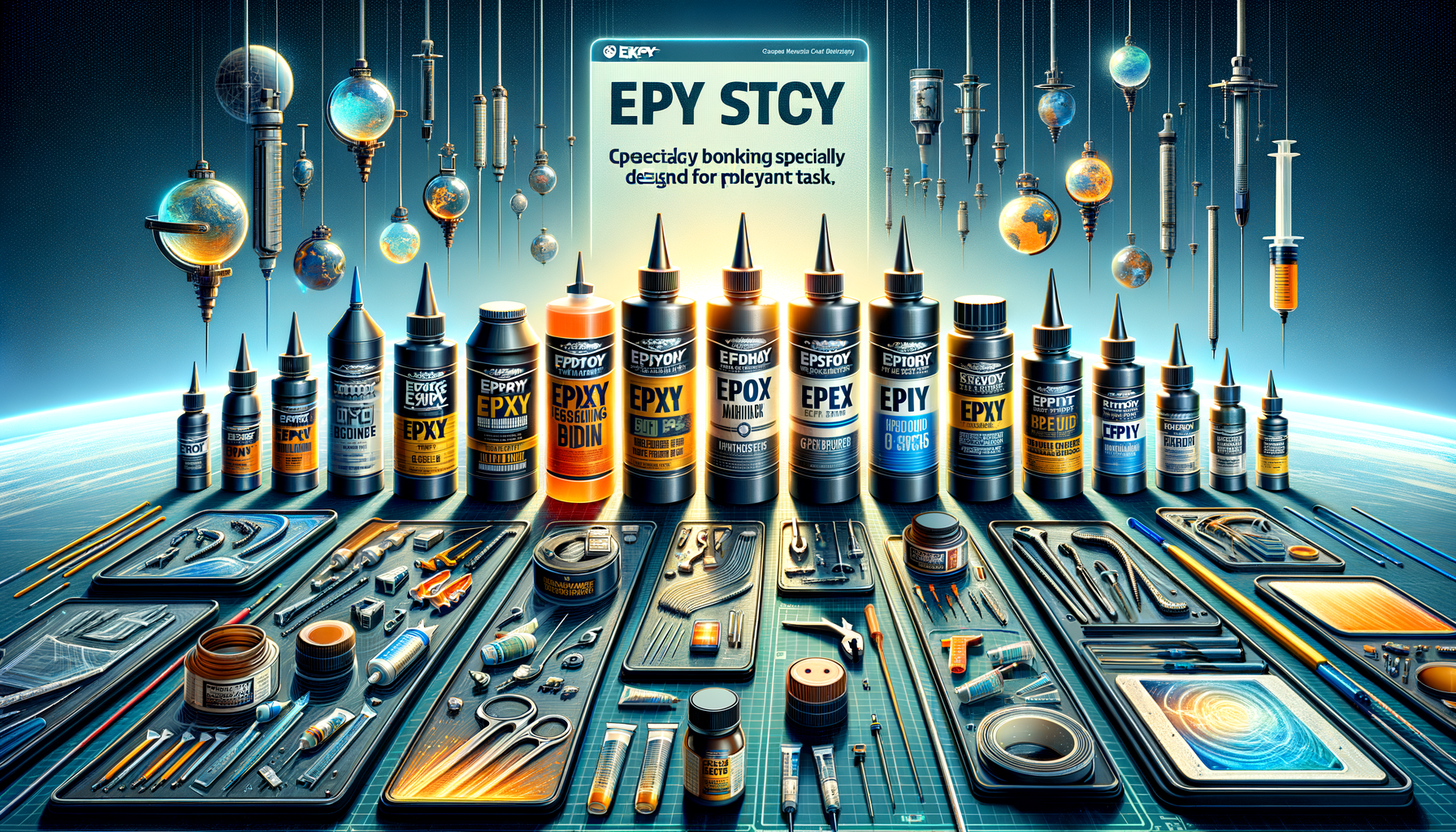
Are you tackling a DIY project that involves plastic materials and want a reliable adhesive that won’t let you down? Epoxy adhesives are trusted for creating strong bonds on a variety of surfaces—including plastic.
Our Top Picks
Choosing the right epoxy can make or break your project. Let’s delve into the top-ranked epoxies for plastic we’ve handpicked for their exceptional performance.
Our #1 Top Pick: J-B Weld 50139 Plastic Bonder Body Panel Adhesive and Gap Filler Syringe
When it comes to plastic repair, the J-B Weld 50139 is a front-runner, and for good reason. This two-part urethane adhesive is designed to handle the rigors of plastic body panel and gap repairs. Once cured, it forms a tough, rigid bond that is highly resistant to shock, vibration and temperature fluctuations. Users love its quick set time of 15 minutes and a cure time of just 30 minutes, making it ideal for projects needing speed without compromising strength. It’s also easily sandable for a smooth finish after curing.
Pick #2: Gorilla 2 Part Epoxy
Gorilla is a well-known brand for its durable and versatile adhesives. This two-part epoxy from Gorilla comes with a syringe applicator that dispenses resin and hardener in equal amounts, ensuring a perfect mix. With a five-minute set time, it is fantastic for quick fixes. After curing, it delivers an impressively strong bond that works on not just plastic but various materials. It’s also water-resistant and can withstand moderate exposure to the elements.
Pick #3: Loctite Epoxy Plastic Bonder 0.85-Fluid Ounce Syringe
Loctite is another heavyweight in the adhesives market. Their Epoxy Plastic Bonder is specifically formulated for plastics, providing a powerful bond that is water-resistant and resilient to solvents and freezing temperatures. It does not shrink and can be tinted with earth pigments, cement or sand for color matching. The set time is about 20-25 minutes with a cure time of 24 hours for maximum bond strength. Its reliability makes it a favorite among professionals and hobbyists alike.
Pick #4: Devcon 22045 Plastic Welder
The Devcon 22045 Plastic Welder is a heavy-duty adhesive that’s perfect for stronger repairs that need to hold up to stress. The bond it forms is robust, capable of withstanding tough conditions. It is particularly suitable for automotive plastics but is versatile for other uses as well. The handling time is about 15 minutes, and a full cure is achieved in 24 hours. It also boasts high resistance to heat and chemicals once cured.
Pick #5: 3M Scotch-Weld Plastic & Rubber Instant Adhesive PR40
3M is synonymous with industrial-grade products, and its Scotch-Weld Instant Adhesive PR40 is no exception. True to its ‘instant’ tag, this adhesive bonds quickly — typically within seconds — which can be a major plus for projects that require rapid adherence. The PR40 works various substrates, including hard-to-bond plastics and rubbers. This makes it a versatile pick, ideal for production line applications where speed and strength are key factors.
What to Know Before You Buy
- Surface Compatibility: Ensure the epoxy is suitable for the type of plastic in your project. Different plastics like PVC, ABS, or polystyrene can require specific types of adhesives.
- Bond Strength: Understand the strength requirements of your application. Not all epoxies are created equal—some offer a stronger bond than others.
- Set and Cure Time: These times can vary. Consider how quickly you need the bond to set and how much time you have for it to fully cure.
- Application Method: Choose an epoxy that has an application method you are comfortable with. Some come with easy-to-use syringes, while others may require mixing.
- Resistance Properties: If your project will be exposed to harsh conditions, such as high temperatures, chemicals, or water, look for epoxies with appropriate resistance.
Factors to Consider Before Buying
- Viscosity: The thickness of the epoxy can impact flow and penetration into the surfaces you are bonding. Thinner epoxies can reach into small crevices but might run on vertical surfaces.
- Temperature Range: The performance of epoxy can be affected by temperature. Consider the environmental conditions where the repair will occur and ensure the epoxy s suited to handle it.
- Durability: Consider whether the bond needs to withstand impact, vibration, or movement. Some epoxies offer more flexibility which can be advantageous for high-stress bonds.
- Safety: Check the safety data sheets for the epoxy you intend to use. Understand necessary precautions and whether you need to use safety equipment like gloves or respirators.
- Environmental Considerations: Some epoxies are more eco-friendly than others. If this is a priority for you, research the product’s environmental impact.
Why Trust ChooseRight?
You might be asking yourself—why should you trust these picks? At ChooseRight, we take product recommendations seriously. We’ve meticulously reviewed hundreds of epoxies, sifting through thousands of user reviews, and recording feedback from seasoned professionals. With a thorough and exhaustive investigative process, we have dedicated time and resources to ensure that our recommendations stand up to real-world use and meet the high standards required by those who rely on them.
Finishing Thoughts
Whether you’re repairing a favorite toy, fixing automotive parts, or embarking on a crafts project, the right epoxy for plastic can make all the difference. With the information provided, you’re well-equipped to choose an adhesive that suits your needs. Remember to always follow the manufacturer’s instructions and take appropriate safety precautions when using epoxy resins. Your perfect DIY project might just be one strong bond away!
Frequently Asked Questions
What is epoxy for plastic?
Epoxy for plastic is a type of adhesive specifically formulated to bond plastic surfaces together or to other materials. It is usually a two-part system consisting of a resin and a hardener that need to be mixed before application.
Can I use any epoxy on all types of plastic?
No, not all epoxies are suitable for every type of plastic. Some plastics require special formulations to ensure a strong bond. Always check the product compatibility with your specific type of plastic.
How do I prepare the plastic surface before applying epoxy?
It’s essential to clean the plastic surface thoroughly to remove any grease, oil, or dirt. Sanding the area lightly can also help the epoxy adhere better. After preparing the surface, clean it with alcohol or a similar solvent and let it dry completely before applying the epoxy.
What’s the difference between epoxy and super glue for plastic?
Epoxy is generally stronger and more durable than super glue and is preferred for heavy-duty bonding or where a filler is necessary. Epoxy typically has a longer curing time compared to the quick-bonding cyanoacrylates found in super glue.
How long does it take for plastic epoxy to cure?
The curing time for plastic epoxy can vary from a few minutes to several hours, depending on the product. Be sure to read the manufacturer’s instructions for the specific curing time of the epoxy you’re using.
Can epoxy for plastic be used to fill gaps?
Yes, many epoxy adhesives for plastic are also suitable for gap filling. Make sure to choose a gap-filling epoxy if that’s a requirement for your project.
Is epoxy for plastic resistant to heat and chemicals?
Many epoxies have good heat and chemical resistance, but this can vary between products. Check the specifications of the epoxy you plan to use to ensure it meets your needs in terms of temperature and chemical exposure.
Can I paint over plastic epoxy?
Once fully cured, many plastic epoxies can be sanded and painted. However, it is crucial to check the manufacturer’s recommendations and potentially test a small area first.
Does epoxy for plastic work on wet surfaces?
Most epoxies require dry surfaces to adhere properly. However, there are some specialty epoxies that are designed to work on damp or even underwater surfaces. Always check the product details before application.
How do I remove excess or spilled epoxy from plastic?
To remove uncured epoxy, use a cloth dampened with alcohol or acetone to wipe it away. Once the epoxy has cured, it may have to be sanded or scraped off carefully to avoid damaging the plastic.
Is epoxy for plastic environmentally friendly?
The environmental friendliness of epoxy can vary between products. Some may contain volatile organic compounds (VOCs) or other hazardous materials. Look for eco-friendly epoxies if this is a concern for you.
What safety precautions should I take when using epoxy with plastic?
Always work in a well-ventilated area and wear appropriate protective gear such as gloves and safety glasses. Follow all safety instructions provided by the epoxy manufacturer.







